Diminutas nanopartículas de fluoruro de tierras raras activan el crecimiento de las células tumorales mediante interacciones polares eléctricas
Resumen
Las interacciones extracelulares localizadas entre nanopartículas y receptores de señales transmembrana bien pueden activar el crecimiento de células cancerosas. Aquí, diminuto LaF 3 y PrF 3 Las nanopartículas en suspensiones DMEM + FBS estimularon el crecimiento de células tumorales en tres líneas celulares humanas diferentes (A549, SW837 y MCF7). La distribución del tamaño de las nanopartículas, la activación de las vías de señalización de AKT y ERK y las pruebas de viabilidad apuntaron a la estimulación mecánica de los sitios de unión a la adhesión de los ligandos de las integrinas y el EGFR a través de una acción sinérgica de un conjunto de nanopartículas de tamaño diminuto (<10 nm). Si bien las nanopartículas de tamaño diminuto pueden estar bien asociadas con la activación de EGFR, la interacción de la integrina con las nanopartículas sigue siendo un problema multifacético. Un motivo teórico muestra que, dentro de la escala de fuerza pN requerida, cada sitio de unión de adhesión de ligando puede ser activado por una nanopartícula dieléctrica de tamaño diminuto a través de la interacción de dipolo eléctrico. El tamaño de la nanopartícula activa permaneció especificado por la cantidad de cargas superficiales en el sitio de unión de adhesión del ligando y la nanopartícula, y también por la distancia de separación entre ellos. El componente polar de la fuerza del dipolo eléctrico permaneció inversamente proporcional a la segunda potencia del tamaño de la nanopartícula, lo que demuestra que solo las nanopartículas dieléctricas de tamaño diminuto podrían estimular el crecimiento de las células cancerosas a través de interacciones eléctricas del dipolo. El trabajo contribuye a reconocer diferentes modos de estrés citoesquelético de las células cancerosas.
Antecedentes
La tumorigénesis es un problema multidimensional que implica cambios genómicos. También se activa por interacciones célula-matriz extracelular (ECM) entre andamios y estructuras citoesqueléticas [1, 2, 3, 4] expresadas mediante el estrés de mecanosensores, similares a las integrinas, de fuerzas celulares multiparte capaces de alterar la programación genómica [5]. Las interacciones del microambiente tumoral con los armazones de ECM generalmente activan las proteínas de adhesión focal de la membrana celular y los receptores de señales transmembrana (TSR), los receptores del factor de crecimiento epidérmico (EGFR), el factor de crecimiento endotelial vascular (VEGFR) o los receptores del factor de crecimiento nervioso (NGFR). Los mecanosensores regulan el crecimiento de las células tumorales mediante la transacción de señales entre el dominio activo extracelular de las células [6, 7, 8, 9] y los filamentos de actina F intracelulares, al desencadenar una avalancha de reacciones de fosforilación.
Los cambios conformacionales de las proteínas y la excitación de las vías de TSR requieren que la fuerza de activación se sitúe en el rango de fuerza pN, y ciertamente por debajo del calibre nN [10]. Además del estrés mecánico aleatorio y la fuerza de afinidad química activa, la eficiencia de unión (fuerza de unión) entre las nanopartículas (NP) y las proteínas de la membrana celular se puede modular a través de interacciones polares eléctricas de corto o largo alcance u otros tipos de interacciones dispersivas. En el área de superficie limitada de las NP, solo una cierta cantidad de proteínas se puede unir durante el tiempo suficiente para ser biológicamente activas [11], y se reconoció que las interacciones locales confinadas en el espacio con el medio biológico son responsables de un conjunto de funcionalidades celulares divergentes. rutas [12]. En consecuencia, las vías de transacción de señales de la interacción proteína-NP están señalando problemas de seguridad para las NP [11, 13].
Dado que la respuesta favorable o adversa en las células de los NP es específica del tipo [11], el vínculo entre los NP y las marcas biológicas debe establecerse caso por caso [14, 15].
Los resultados contradictorios de las células tumorales expuestas a las NP, ya sea para la eficacia ablativa o de crecimiento tumoral o los niveles variables de toxicidad de las NP [16, 17], también están surgiendo problemas de seguridad. Sin embargo, a pesar de los avances, hoy en día existe un desconocimiento sobre las vías específicas por las que las NP interactúan con las células eucariotas, lo que impide la identificación de un enfoque terapéutico universal de las NP. Debido a que las NP de diferentes tamaños y las diversas químicas de la superficie suelen desviar las respuestas celulares, incluida la unión de las NP al receptor de membrana y la actividad de las TSR, la toxicidad de las NP está relacionada con la morfología de los tensioactivos, el estado de carga eléctrica, la concentración y composición de proteínas y nanomateriales en la MEC. [18,19,20,21] y, finalmente, la fuerza del enlace molecular entre las NP y los fenotipos celulares [22].
Estudios previos de melanoma y carcinomas de cuello uterino expuestos a sílice, NP de oro y nanotubos de carbono reconocieron que el tamaño de las NP activa el crecimiento de las células tumorales de forma selectiva [23,24,25,26,27]. La correlación entre las señales de TSR en la línea celular de cáncer SK-BR-3 humana y el tamaño de las NP de oro y plata modificadas demostró que, aunque las NP de 2 a 100 nm de tamaño reformaron la transducción de señales, se logró una inmensa diferencia en la actividad apoptótica cuando las células interactuaron con 40 NP de tamaño –50 nm [26]. Recientemente, también se sugirió que cambiando el tamaño de las NP de oro de 5 a 40 nm, las tasas de crecimiento de las líneas celulares de cáncer A549 y 95D posiblemente se ajustaron. Específicamente, las NP de tamaño de 5 nm inhibieron cualquier proliferación de ambos tipos de células, mientras que las NP de tamaño ~ 10 nm no tuvieron ningún efecto sobre el crecimiento celular [27]. Asimismo, las células A549 y THP-1 expuestas a SiO 2 Los NP mostraron citotoxicidad dependiente del tamaño, así como los NP de tamaño de 15 nm también se correlacionaron con altos niveles de citotoxicidad. Por el contrario, las NP de 60 nm presentaron una menor toxicidad. Por último, las NP de tamaño de 200 nm aumentaron el crecimiento de células madre a través de la activación de ERK1 / 2, mientras que las NP de tamaño de 2-4 µm fueron capaces de activar diferentes vías de transducción de señales [28]. Las NP de pequeño tamaño conjugan el EGFR y activan la proteína quinasa B (AKT) y las vías de transacción de señales de la quinasa regulada por señal extracelular (ERK) que inflaman el crecimiento celular.
Las nanopartículas de tierras raras (RE-NP) también pueden interactuar con dominios específicos como los sitios de adhesión dependientes de iones metálicos (MIDAS), el ajuste a MIDAS (ADMIDAS), los sitios de unión de iones metálicos sinérgicos (SyMBS) y el sitio de unión de adhesión de ligandos (LABS) , ubicado en el α ν β 3 subunidad u otras subunidades de integrinas [29, 30].
Asimismo, los RE-NP suponen un grado adicional de flexibilidad en la interacción de los NP tumorales [31,32,33,34]. Mientras que los NP de ceria (nanoceria) mostraron una acción protectora contra los daños celulares de diferentes radicales [35], los niveles bajos de concentración de NP de ceria modificados aumentaron mucho la proliferación de células de hepatoma al reducir la apoptosis mediante la activación de las vías de señalización de AKT / ERK [36]. Normalmente, un conjunto de NP que rodean la célula es responsable de estrés citoesquelético y defiende igualmente la interacción química, nanotermodinámica (Hill) [37], entrópica o eléctrica de dipolo entre NP y mecanosensores. Sin embargo, hasta ahora, la comprensión de las interacciones entre NP, TSR y células sigue siendo vaga y no está disponible.
En principio, el fuerte carácter iónico de los compuestos RE debería estimular los mecanosensores de las células a través de interacciones eléctricas. Además, debido a que los iones RE se utilizan ampliamente en diferentes aplicaciones, es vital analizar su contribución potencial al crecimiento de células tumorales para implicar protocolos de protección de la salud pública adecuados. Fluoruro de lantano (LaF 3 ) y fluoruro de praseodimio (PrF 3 ) se utilizan en lámparas fluorescentes, vidrios de colores de radiación, fibra óptica, aplicaciones de esmalte y electrodos. LaF 3 se elabora en un tipo específico de vidrios, revestimientos de lámparas de fósforo, tratamiento de aguas y catalizadores. También es un componente esencial de un vidrio de fluoruro comercial (ZBLAN), que mezclado con fluoruro de europio se utiliza para comunicaciones ópticas y como membrana de cristal en electrodos de fluoruro selectivos de iones con buena transmitancia en el infrarrojo. Igualmente, PrF 3 también se emplea en luces de arco de carbono para la industria cinematográfica, iluminación de estudio y proyectores. Los vidrios de fluoruro dopados con praseodimio también se utilizan en amplificadores de fibra óptica monomodo.
Por lo tanto, este trabajo demuestra que los RE-NP de tamaño pequeño tenían la potencia de estimular el crecimiento de células tumorales a través de interacciones eléctricas dipolo.
El artículo está organizado en tres secciones. Primero, la distribución de tamaño, las interacciones y la geometría de los NP se analizan aplicando dispersión dinámica de luz (DLS), microscopía de fuerza atómica (AFM), microscopía electrónica de transmisión (TEM), difracción de rayos X (XRD), bidimensional rápido. Análisis por transformada de Fourier (2D-FFT) y espectroscopia ultravioleta al vacío (VUV 110–180 nm). A continuación, la correlación entre el nivel de crecimiento de tres líneas celulares de cáncer humano diferentes (A549, SW837 y MCF7) con la distribución de tamaño y la concentración de LaF 3 y PrF 3 Se establece NP. Finalmente, dentro de un límite de fuerza requerido de 1 pN para activar los mecanosensores y, posteriormente, el crecimiento de las células tumorales, la viabilidad de las células tumorales se ajusta a un motivo teórico de interacción dipolo eléctrica entre un RE-NP y un LABS. El trabajo contribuye a la identificación y clasificación de diferentes tipos de estrés citoesquelético e interacciones entre NP y mecanosensorial de células cancerosas.
Resultados
Tamaño y estructura de los NP
Primero, espectroscopía DLS, AFM, TEM, XRD, FFT, VUV y t Se aplicaron estadísticas de prueba para extraer la distribución de tamaño de RE-NP en suspensiones líquidas (Figuras 1, 2, 3, 4, 5, 6 y 7). A continuación, se utilizaron pruebas de viabilidad de células y ensayos de transferencia Western (Wb) para identificar la activación de los mecanosensores específicos por RE-NP.
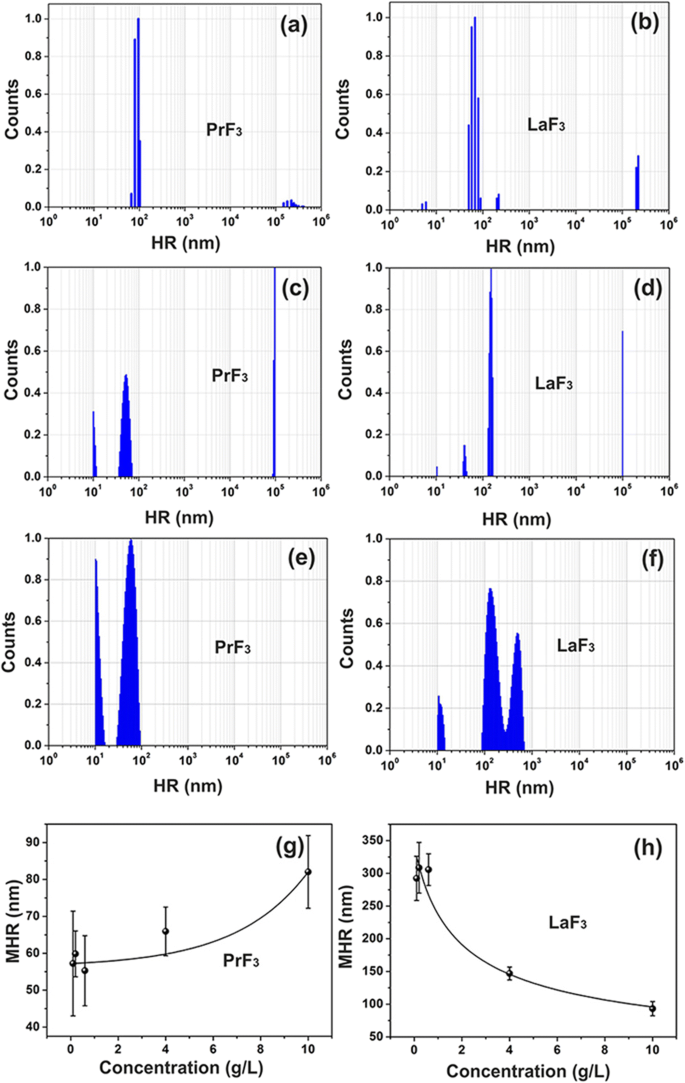
Espectros de distribución de tamaño DLS de suspensiones de RE. a, b PrF 3 y LaF 3 NP (5 g / L) en agua. c, d PrF 3 y LaF 3 NP (5 g / L) en DMEM + FBS. e, f PrF 3 y LaF 3 NP (0,1 g / L) en DMEM + FBS. g, h Radio hidrodinámico medio (MHR) con desviación estándar de PrF 3 y LaF 3 NP en DMEM + FBS a diferentes niveles de concentración
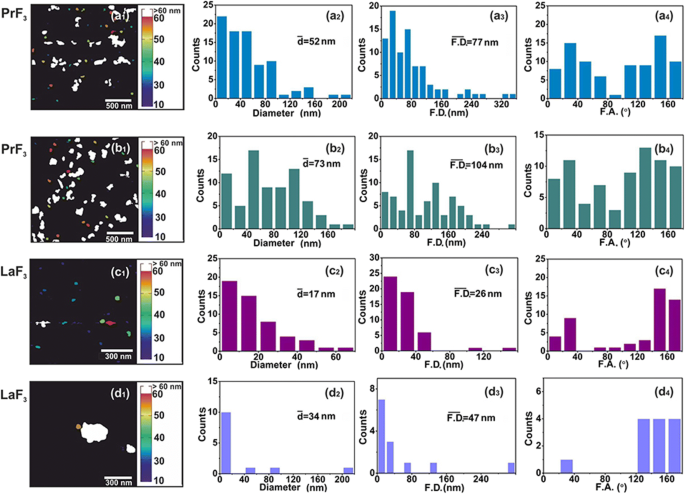
AFM digital ( x , años ) histogramas de tamaño de RE-NP. ( a1 – d1 ) PrF 3 (2 × 2 μm 2 ) y LaF 3 (1 × 1 μm 2 ) NP en suspensiones DMEM + FBS. ( a2 – d2 ) ( x , años ) histogramas de tamaño de diámetro de área circular igual media \ (\ left (\ overline {d} \ right) \) de RE-NP. (a3 – d3) ( x , años ) histogramas de tamaño de los diámetros de área de Feret \ (\ left (\ overline {\ F.D.} \ right) \) de RE-NP. ( a4 – d4 ) Histogramas del ángulo de Feret (F.A.) relativos a x -eje. Los RE-NP se orientaron a lo largo de dos direcciones principales entre ± (44–60 °)

TEM digital ( x , años ) histogramas de tamaño de RE-NP. ( a1, b1 ) Imágenes TEM de RE-NP. Las líneas amarillas indicaban límites 2D entre RE-NP. ( a2, b2 ) ( x , años ) histogramas de tamaño de diámetro de área circular igual media \ (\ left (\ overline {d} \ right) \) de RE-NP. ( a3, b3 ) ( x , años ) histogramas de tamaño del diámetro del área de Feret \ (\ left (\ overline {\ F.D.} \ right) \) de RE-NP. ( a4, b4 ) Histogramas del ángulo de Feret (F.A.) relativos a x -eje con direcciones preferenciales a ± (44–60 °). ( c ) Tamaño del histograma del diámetro de Feret de RE-NP de tamaño pequeño y minúsculo extraídas de imágenes de AFM y TEM para 4 μm 2 áreas
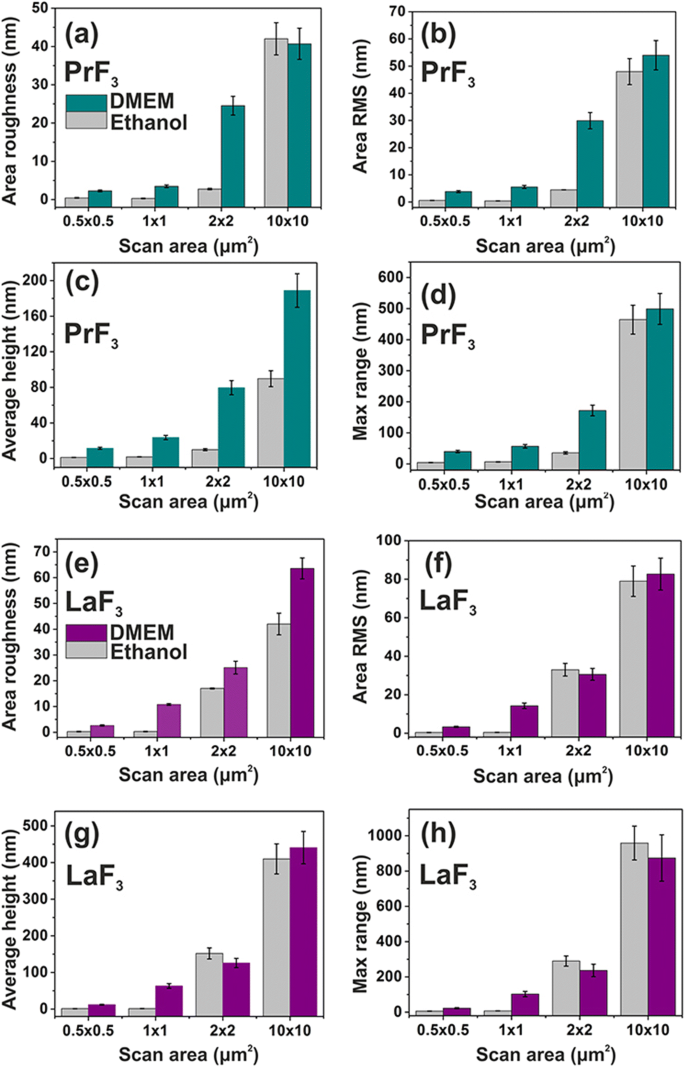
Histogramas de parámetros de superficie (altura z) de PrF 3 y LaF 3 RE-NPs sobre sustrato de vidrio en DMEM + FBS y etanol para diferentes áreas de escaneo. un , e Rugosidad del área. b , f Área RMS. c , g Altura media. d , h Z máximo -rango
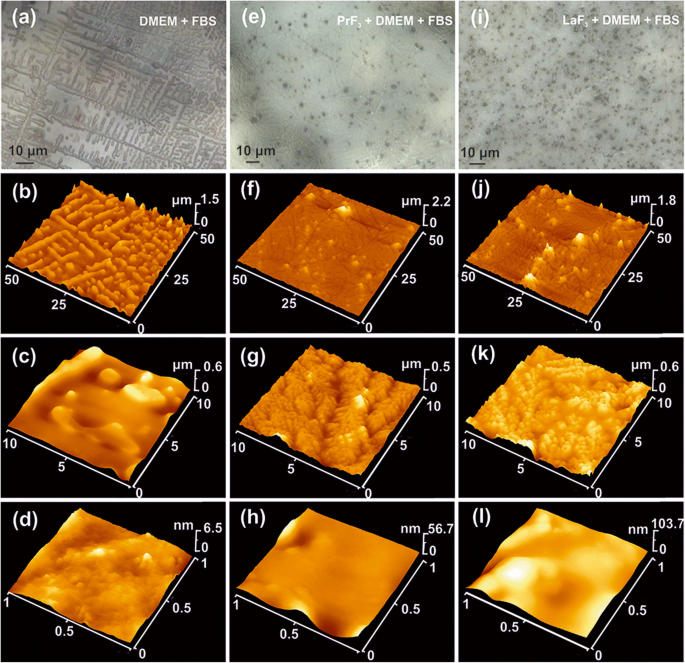
Imágenes ópticas y AFM de RE-NP secas en DMEM + FBS. un - d Óptico ( a ) e imágenes AFM ( b - d ) de DMEM + FBS mostrando estructuras autoensambladas de 5 μm. e - h CCD ( e ) e imágenes AFM ( f - h ) de PrF 3 NP en medios DMEM + FBS que muestran estructuras autoensambladas de dendrita de 500 nm. yo - l CCD ( i ) e imágenes AFM con diferentes aumentos ( j - l ) de LaF 3 NP en DMEM + FBS que muestran estructuras autoensambladas de dendrita de 100 nm
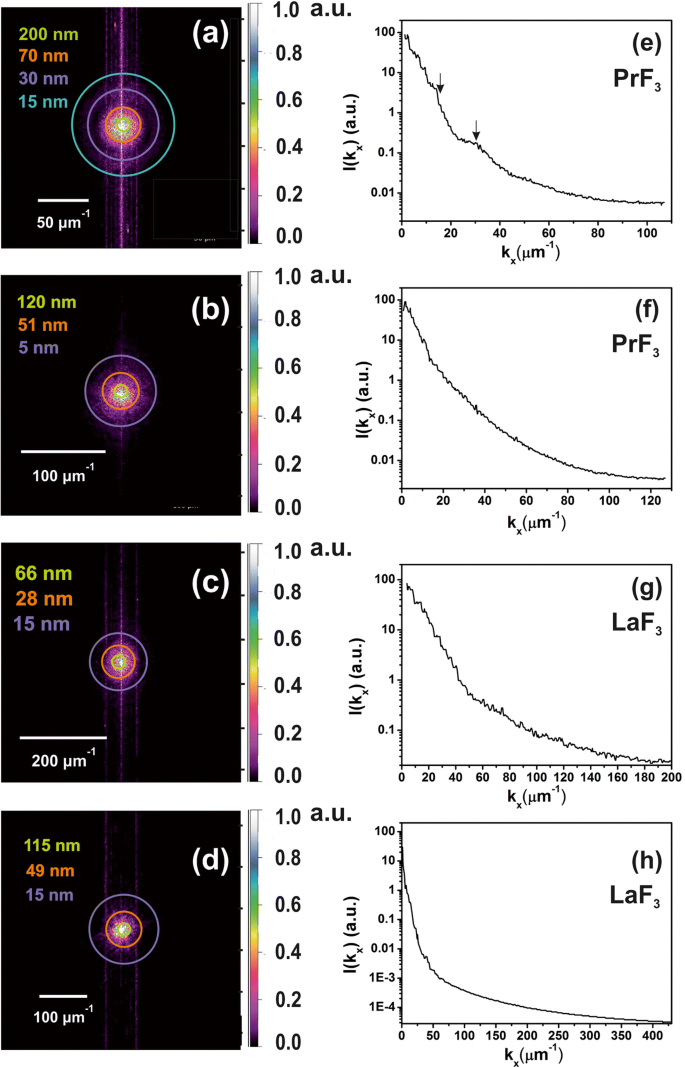
Espectros 2D-FFT de z -altura de la distribución de los RE-NP secos en medios DMEM + FBS que evidencian la presencia de NP de pequeño tamaño en las suspensiones líquidas. un , b distribución de altura z de PrF 3 NP de imágenes AFM, Fig. 2 (a1, b1). Pequeño z -se identificaron características de altura (~ 5 nm) en ( b ). c , d distribución de altura z de LaF 3 NP de imágenes AFM, Fig. 2 (c1, d1). e , f Espectros de poder de z -vectores de onda de altura de PrF 3 NP a lo largo de la x -eje. g , h Espectros de poder de z -vectores de onda de altura de LaF 3 NP a lo largo de la x -eje
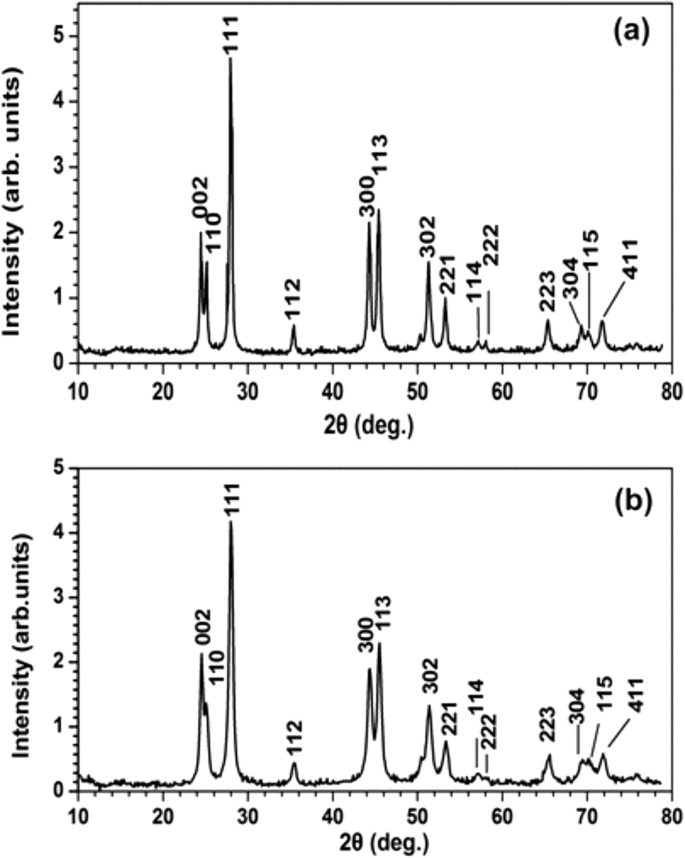
Espectros XRD de a PrF 3 y b LaF 3 NP. Los diámetros de superficie media de PrF 3 y LaF 3 Los NP fueron ~ 23 ± 4 y ~ 15 ± 4 nm, respectivamente
DLS
Las mezclas heterogéneas turbias se formaron inicialmente mediante la adición de RE-NP en medios de cultivo celular, lo que evidencia la complejidad de las interacciones entre RE-NP en suspensiones líquidas. Se identificaron estructuras diminutas (<10 nm), pequeñas (> 10 y <20 nm) y de gran tamaño (> 20 nm) de RE-NP para ambas PrF 3 y LaF 3 solubles (Fig. 1a – d).
Los valores de radio hidrodinámico medio (MHR) de RE-NP de gran tamaño (55-83 nm para PrF 3 y 99–296 nm para LaF 3 ) se arrastraron directa e inversamente proporcional al nivel de concentración de NP (0,1-10 kg m −3 ) en Eagle modificado de Dulbecco líquido con suero bovino fetal (DMEM + FBS), Fig. 1g, h. Además, el MHR de pequeño tamaño LaF 3 y PrF 3 Las NP permanecieron constantes, 10,66 ± 0,74 nm y 10,64 ± 0,40 nm, respectivamente, a diferentes niveles de concentración de RE-NP. La MHR de RE-NP se mantuvo sin cambios durante al menos 6 días. Después de secar las suspensiones de RE-NP, fue imposible volver a disolver el polvo de RE, ya que las aglomeraciones de gran tamaño estabilizadas por interacciones fuertes forzaron la precipitación.
Imágenes AFM y TEM de RE-NP y análisis de superficie
Para una distribución de tamaño confiable y estadísticas de RE-NP de tamaño pequeño en DMEM + FBS a 0.1 kg m −3 AFM (áreas de escaneo 1 × 1 y 2 × 2 μm 2 ) y TEM también se aplicaron imágenes (Fig. 2 (a1 – d1) y Fig. 3 (a1, b1)). Después de transferir las gotas líquidas de las RE-NP en DMEM + FBS al sustrato de vidrio, se identificó un número relativamente grande de pequeñas RE-NP no agregadas [38] tanto del tamaño medio como del diámetro medio de Feret de las NP ( Fig. 2 (a2 – d2, a3 – d3) y Fig. 3 (a2, b2, a3, b3)). Además, los histogramas de la distribución de ángulos de los diámetros AFM y TEM Feret (para la dimensión más grande de NP) indicaron que ambos RE-NP se orientaron preferentemente a lo largo de dos direcciones entre ± (44–62 o ), en relación con x -eje (Fig. 2 (a4 – d4) y Fig. 3 (a4, b4)).
A pesar de eso z -la distribución de la altura de los NP no proporcionó información directa sobre la distribución general del tamaño de los NP, es una herramienta comparativa útil para la primera estimación de ( x , años ) distribución de tamaño porque la altura z y ( x , años ) las distribuciones permanecen interrelacionadas [38].
Los parámetros de superficie media de ambos PrF 3 y LaF 3 en suspensiones secas para diferentes áreas de escaneo AFM también se muestran en la Fig. 4. La pequeña z -los valores de altura indicaron una z muy uniforme -distribución de altura de ambos RE-NP para pequeños 1 × 1 μm 2 escanear áreas. Por el contrario, tanto para RE-NP como para áreas de escaneo más grandes, el z -la distribución de la altura fue significativamente más amplia. El bajo z -Los valores de distribución de altura en áreas de escaneo pequeñas reflejan la presencia de RE-NP de tamaño pequeño en las suspensiones líquidas. Los valores de los parámetros de superficie en el medio DMEM + FBS fueron en promedio mayores que en el etanol, mostrando un estado reactivo complejo entre proteínas y RE-NP, de acuerdo con la estructura multifacética de la Fig.5 y los datos 2D-FFT (Fig.6 ). En general, LaF 3 Los NP exhibieron una respuesta intrigante en suspensiones secas y parámetros de rugosidad de superficie más extensos que PrF 3 NP.
FFT
Se agregaron anillos de colores en radios seleccionados en los espectros 2D-FFT (Fig. 6a-d). Los ciclos representan diferentes distribuciones de tamaño de NP en el espacio euclidiano, desde un tamaño minúsculo igual al tamaño de un píxel (1,9 a 3,9 nm) hasta un tamaño considerable de ~ 2 μm, que era el límite de exploración superior de la punta de AFM en el z -eje (Fig. 6e – h). Un deconvolucionado del z -los valores de altura con el radio de la punta AFM proporcionan una resolución real en el z -distribución de altura de ~ 5 nm. Los espectros 2D-FFT demostraron una distribución intensa de vectores de onda cerca del centro, debido a una media z -altura de RE-NPs de ~ 44 nm. Los patrones de FFT exhibieron una estructura de halo, que se difumina gradualmente, debido a una amplia estructura polidispersa de tamaño diminuto identificada en los espectros 2D-FFT. Como solo el halo apareció en los espectros sin ningún patrón de difracción para ambos espectros 2D-FFT, faltaban estructuras autoensambladas regulares. Las longitudes de correlación características obtenidas de los patrones 2D-FFT en forma de anillo de PrF 3 y LaF 3 fueron ~ 51, 70 nm y 28, 49 nm, respectivamente, de acuerdo con los valores de MHR extraídos de los espectros DLS.
XRD
La espectroscopia XRD caracterizó la estructura cristalina y proporcionó información complementaria sobre el tamaño de PrF 3 y LaF 3 NP (Fig. 7). Los picos de difracción agudos, que corresponden a la estructura de fase hexagonal estándar para ambos RE-NP, revelan un alto estado cristalino de las fases de aglomeración. Al usar la fórmula de Scherrer (\ (\ tau =\ frac {0.9 \ lambda} {\ beta \ cos \ left (\ theta \ right)} \ Big) \), el diámetro medio promedio del círculo de áreas iguales (MEAC) τ de PrF 3 y LaF 3 Se estimó que las NP eran ~ 23 ± 4 y ~ 15 ± 4 nm, respectivamente.
Espectroscopia VUV
El espectro de transmisión VUV del PrF 3 hidroscópico Capa de NP depositada en CaF 2 sustrato, de 125 nm (~ 10 eV) a 190 nm (~ 6,5 eV) se muestra en la Fig. 8. Los picos de VUV a 140-170 nm atribuidos previamente a las transiciones de Pr 3+ iones trivalentes del suelo 4f configuración del estado electrónico de los componentes Stark del 4f5d configuración electrónica dentro de YF 3 , LaF 3 , KY 3 F 10 y LiLuF 4 matriz monocristalina y se superponen con una banda de absorción de agua VUV, revelando la presencia de moléculas de agua unidas en el PrF 3 y LaF 3 cristales.
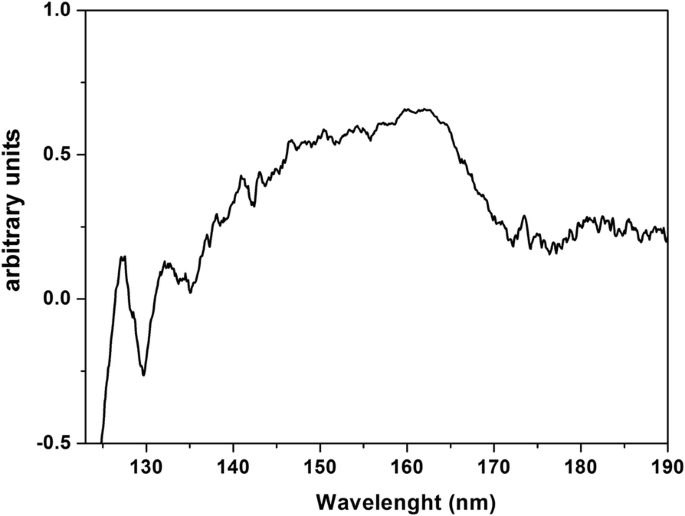
Espectro de transmisión VUV de PrF 3 NP en suspensiones de agua depositadas sobre el CaF 2 seco sustrato. El espectro indica adherencia y atrapamiento de agua dentro de PrF 3 NP
Prueba de viabilidad
Tras el análisis de distribución de tamaño y las estadísticas de RE-NP, se utilizó la prueba de viabilidad de las sales de tetrazolio solubles en agua (WST) para controlar la toxicidad de PrF 3 y LaF 3 NP para tres líneas celulares de cáncer humano, la A549 derivada de cáncer de pulmón, la SW837 derivada de cáncer de colon y la MCF7 derivada de cáncer de mama. Se utilizaron tres concentraciones diferentes de suspensiones RE-NPs (0.5, 1 y 5 mM) en DMEM + FBS (A549, SW837) y medio Roswell Park Memorial Institute con Fetal Bovin Serum (RPMI + FBS) (MCF7). Las líneas celulares se colocaron inicialmente en placas de 96 pocillos y se dejaron adherir durante la noche. Para estar dentro de la región lineal de crecimiento celular y evitar la saturación (Fig. 9a) un día después, medio fresco que contiene PrF 3 y LaF 3 se agregaron suspensiones y se realizaron pruebas de viabilidad 24 y 48 h después de la adición de RE-NP, o 48 y 72 h después del momento inicial de la siembra celular. Sin embargo, para las tres concentraciones y las tres líneas celulares de cultivo, se detectó una diferencia de sobrecrecimiento, siempre que no se reemplazara el medio y no se agregaran RE-NP adicionales en el cultivo, prácticas que alteran las condiciones iniciales del experimento. Además, era imposible colocar en placa una concentración de células inferior a ~ 5 × 10 4 células por pocillo porque la confluencia de las tres líneas celulares era demasiado pequeña para garantizar un crecimiento celular medible. La configuración experimental óptima se estableció para ~ 5 × 10 4 células por pocillo.
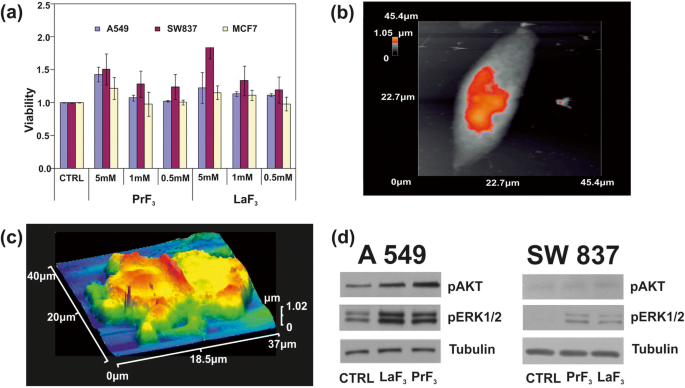
un Histogramas del ensayo de viabilidad WST de tres líneas celulares cancerosas diferentes (A549, SW837, MCF7) tratadas con diferentes concentraciones de PrF 3 y LaF 3 NP en medios biológicos. b Imagen AFM de una sola célula cancerosa A549. c Imagen AFM de una célula cancerosa A549 dividida en RE-NP en DMEM + FMS. d Análisis de fosforilación Wb de las células A549, SW837 con rutas AKT y ERK
A mayor concentración (5 mM), para ambas suspensiones de RE, se obtuvo un crecimiento ascendente para todas las líneas celulares (Fig. 9b, c). Entre ellos, el valor de crecimiento más alto fue para la línea SW837 (86%, LaF 3 ). Menos pronunciado, pero aún relevante, se observó un sobrecrecimiento celular (15%) para la línea celular MCF7 a 5 mM. A t análisis estadístico de prueba ( p y Fisher F Los valores) de la viabilidad de las células tumorales mostraron que el crecimiento de las células tumorales no estaba saturado a las 24 h; siguió una ley física desconocida que conecta la viabilidad y la concentración de RE-NP (archivo adicional 1).
Ensayos de fosforilación
También se probó el estado de fosforilación de dos proteínas (Fig. 9d). Usando anticuerpos específicos y ensayos de Wb en las líneas celulares A549 y SW837, crecieron en DMEM + FBS con 5 mM de LaF 3 y PrF 3 Se obtuvieron NP durante 24 h, alta actividad de fosforilación de ERK1 / 2 y AKT en las células tratadas, en comparación con las células de control (CTRL).
Discusión
La tasa de crecimiento relativa de las células cancerosas fue ascendente a niveles de concentración más altos de ambos RE-NP (Fig. 9a). Sin embargo, los valores de MHR de RE-NP en DMEM + FBS se rastrearon directamente (PrF 3 ) e inversamente proporcional (LaF 3 ) a la concentración de RE-NP de 0,1 a 10 kg m −3 (Figura 1g, h). Por lo tanto, los RE-NP con un tamaño promedio superior a ~ 55 nm no deberían tener ningún efecto sobre el crecimiento celular y solo los NP de tamaño pequeño pueden participar en el crecimiento tumoral.
Tamaño y estructura de los RE-NP
Identificación de pequeños RE-NP
A partir de los datos experimentales, se extrajeron el tamaño medio, la distribución y los parámetros estadísticos de los RE-NP. Aplicando t estadísticos de prueba para la "hipótesis nula" de "círculo de área equivalente media" de NP en PrF seco 3 y suspensiones DMEM + FBS, la p El valor del diámetro de NP entre dos imágenes AFM seleccionadas al azar fue ~ 0,001 (archivo adicional 2). Se extrajo un valor de diámetro MEAC (63 nm) con confianza de los datos de AFM, y esto fue comparable con el valor de MHR de los datos de DLS (Fig. 1g).
Por el contrario, el valor del diámetro MEAC de LaF 3 seleccionado al azar Las muestras mostraron un diámetro MEAC promedio de 26 nm con un valor de probabilidad de rechazo más alto ( p =0.07), apuntando a un comportamiento divergente de LaF 3 en suspensiones líquidas. La discrepancia entre el diámetro MEAC y la MHR de DLS (296 nm) (Fig.1) se debe a la complejidad de las interacciones en LaF 3 suspensiones de nuevo. De hecho, para un 2 de 2 × 2 μm Área de escaneo de la punta de AFM, el promedio z -la altura era ~ 140 nm, mostrando la presencia de LaF 3 de gran tamaño NP, transferidas de las suspensiones líquidas sobre el sustrato (Fig. 4). Para la "hipótesis nula" de "valores iguales de diámetro MEAC de muestras TEM seleccionadas al azar", la p los valores también eran pequeños ( p =0,001). Para ambos RE-NP, los valores de diámetro MEAC promedio extraídos de los datos combinados de TEM y XRD para ambos PrF 3 y LaF 3 indicó alto p valores, p =0,29 y 0,06, respectivamente, no permitiendo así ninguna correlación entre los datos TEM y XRD. Solo TEM, AFM (PrF 3 ) y los datos de DLS eran lo suficientemente fiables para extraer los valores de diámetro y núcleo-capa de MEAC (archivo adicional 2).
Además, una distribución de ángulos no isotrópicos de los diámetros de Feret indicó que tanto PrF 3 y LaF 3 Las estructuras eran dieléctricas altamente polarizadas, ya que la distribución del ángulo anisotrópico es una indicación de fuertes interacciones eléctricas polares entre nanocristales. Un estado polarizado diverso de LaF 3 fue responsable de reducir la eficiencia relativa del estado de aglomeración en suspensiones y de aumentar los parámetros de rugosidad de la superficie en muestras secas.
Un análisis de partículas de software de imágenes AFM aleatorias para 5 μL y una concentración de 0,1 kg m −3 identificó un número de ~ 22 y ~ 11 RE-NP con un tamaño inferior a 15 nm y 10 nm ( p =0.001), respectivamente, y una cantidad de ~ 60 RE-NP de imágenes TEM ( p =0,001) en un área de ~ 4 μm 2 , lo que confirma la presencia de RE-NP de tamaño pequeño en las suspensiones (Fig. 3 (c), archivo adicional 2) no detectado con DLS.
Estructura y geometría de RE-NP
La distribución de tamaño de RE-NP es divergente en suspensiones de etanol y DMEM + FBS (Fig. 4). La diversidad se debe a las diferentes interacciones moleculares entre las proteínas adsorbidas, los carbohidratos, los electrolitos y la superficie de las RE-NP, lo que lleva a la formación de capas orgánicas altamente complejas (corona), que modulan las interacciones específicas de las RE-NP con las células en Medio DMEM + FBS.
La interacción entre las moléculas de agua atrapadas en RE-NP higroscópicas y DMEM + FBS también fue vital para la formación de núcleo-capa. También tuvo un efecto profundo sobre las proteínas y los cambios conformacionales en las interacciones intermedias durante la fase inicial de preparación. A medida que la relación superficie-volumen de los NP desarrolló valores altos en las suspensiones, la estabilidad efectiva y las propiedades fisicoquímicas, mecánicas y de flujo de los RE-NP, incluida la capacidad para absorber proteínas, variaron enormemente [39,40,41] .
La distribución comparativa del tamaño de RE-NP en líquido (DLS) y suspensiones solidificadas a través de AFM y TEM mostró que los RE-NP se encapsularon dentro de formas orgánicas formando estructuras dieléctricas núcleo-capa, donde una capa proteica rodea el RE-núcleo. Las imágenes de AFM obtenidas a partir de RE-NP solidificadas en suspensiones DMEM + FBS depositadas sobre sustratos de vidrio también apuntan a la formación de RE-NP multifacéticas y complejos de corona de proteínas (Fig. 5). Mientras que los medios secos formaron un patrón autoensamblado regular de estructuras cristalinas (Fig. 5a-d), las suspensiones de RE-NPs secas mostraron una estructura en capas amorfa con varios puntos negros, visibles incluso con la cámara digital del AFM (Fig. 5e-l) . A mayor aumento óptico, también se detectaron aglomeraciones discretas de formas globulares, más pequeñas que las del medio solo, para ambos RE-NP en DMEM + FBS, junto con estructuras de tipo dendrita, ambas mostrando la complejidad de las interacciones, de acuerdo con la resultados de los parámetros de superficie (Fig. 4). Incluso con la resolución AFM más alta (1 × 1 μm 2 área), el último carril de la Fig.5, no se identificaron agregaciones de RE-NP aisladas, dentro del límite de resolución de ~ 5 nm, en estructuras secas para ambas RE-NP. Los micelios esféricos de color negro, de 1 a 2 μm de largo, que se muestran en las imágenes ópticas, eran grandes formaciones de aglomeración de RE-NP de núcleo-capa. La complejidad de las reacciones entre los RE-NP y DMEM + FBS se visualizó mediante la transformación de las estructuras alargadas autoensambladas a largo plazo en DMEM + FBS puro en estructuras dendríticas.
Los resultados apuntan a la imagen de una única estructura central de RE-NP encapsulada dentro de una capa de proteína. Estas estructuras eran indetectables porque estaban rodeadas de materia orgánica y electrolitos, ambos con reacción cruzada con RE-NP. El espectro VUV de PrF 3 shows some spectral peaks between 140 and 170 nm (Fig. 8). The ionic transitions are overlapped by a VUV water absorption band extended from 145 to 180 nm with a maximum at 168 nm. Only the spectral signatures of the 4f6s electronic configuration with maxima at 132 and 127 nm were present in the spectrum. However, these bands could evince the presence of water in the high hygroscopic PrF3 suspensiones. Water has a rich, structured absorption band in the VUV spectral range centred at 122 nm, revealing the presence of water molecules in the core-shell NPs.
Activation of Mechanosensors
Activation of Integrins by External Forces
The activation of oncogenic pathways by RE-NPs [24], besides the 3D structural nature of TSRs, is based on some Natural Evolution principles for sustaining the viability of cells. First, upon binding a specific external ligand in a LABS, conformational changes along the entire TSR spectrum underline a series of cascading pathways, triggering tumour cell growth (Fig. 9c, d). The transmission of signals advances through the plasma membrane via various protein chains. Signal transduction was via conformational transformations of integrins responding to a high affinity external force (Fig. 10a, b).
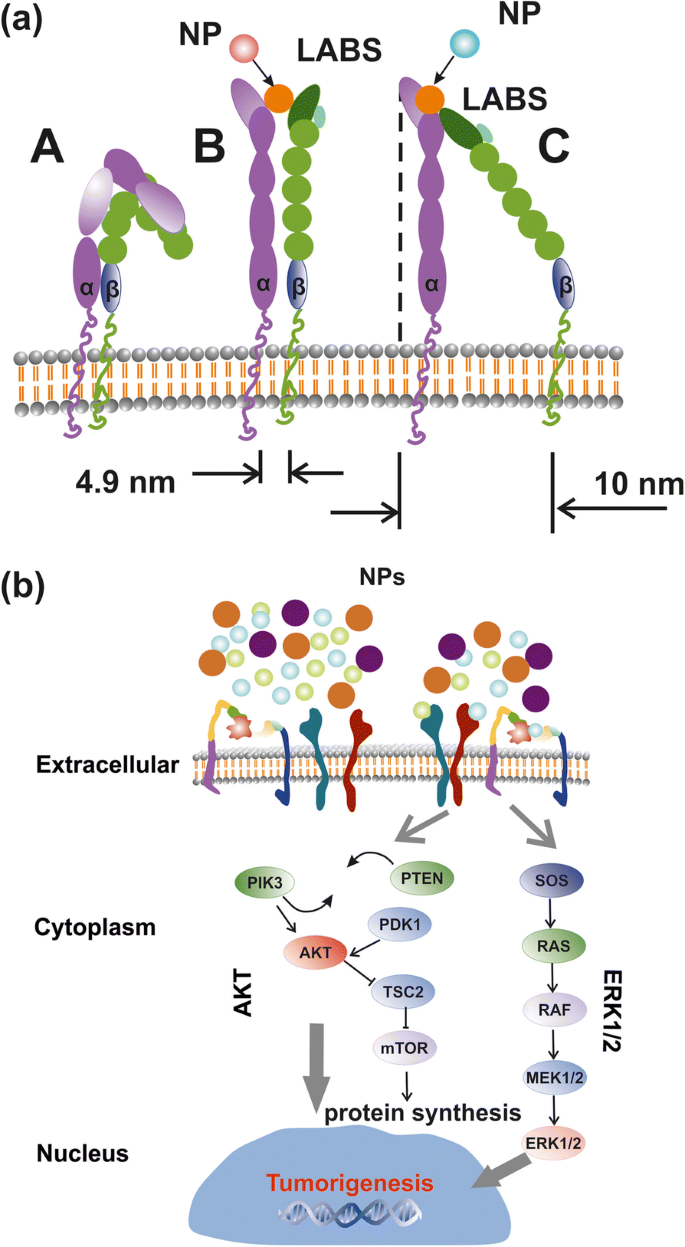
Simplified layout of integrin activation by NPs and signal transaction pathways. un Structure and conformational geometries of integrins at a low (A), medium (B) and high-affinity strengths (C). b AKT and ERK1/2 signal transaction pathways activated by RE-NPs via external integrin stimulation
Because of “life sustainability” and “survival laws” that prevents cancer cell growth by random “noise”, it is required that the strength of the external force should be within a bounded range of values and also the external strength stimulus should apply for a long period on a large number of mechanosensors in a cancer cell. The external strength that stimulates cancer must be slightly larger than the strength of the interatomic molecular forces under normal conditions. For a thermal energy of a ligand at room temperature (kT = 0.025 eV, T = 298 K), and for a regular thermal stress of molecular bonds of ~ 0.05 nm, the mean thermal force acting on the LABS stays for 1.2 × 10 −12 N. In principle, a force above ~ 10 × 10 −12 N acting coherently on the whole set of mechanosensors on a cell should activate signal transduction in tumour cells. Consequently, ignoring any thermal and mechanical stressing in the ECM normal conditions, integrin activation via electrical polar interactions between LABS and NPs has the potency to start signal transduction in cancer cells and to initiate tumorigenesis.
Integrin Structure and Geometry
An integrin receptor in the upright conformation state extends ∼ 20 nm upwards from the cell membrane [42] (Fig. 10a). For no contacts between the two α- and β-subunits, other than those in the headpiece near the ligand-binding pocket, the α- and β-subunits are well separated with their cytoplasmic tails extended out up to ∼ 8 nm [42]. A conic projection geometry (20 nm slant height, 5–10 nm diameter of its circular base), bounded by the α- and β-subunits, defines a projected area on the surface of cell’s membrane between ~ 19 and ~ 80 nm 2 , for a typical mean radius of a tumour cell R c ≈ 5 μm (equivalent surface area of a spherical cell \( {S}_c=4\pi {R}_c^2=3.14\ \mathrm{x}\ {10}^8\ {\mathrm{nm}}^2 \)). By dividing the area S c of a spherical tumour cell surface with the projected area of an integrin on a cell surface, an upper limit of the number of integrin receptors for these projected areas was n int = 1.6 x 10 7 and 3.9 × 10 6 respectivamente. These numbers are compared with the mean number of integrins on a cell \( {\overline{N}}_{int}\approx 2\ \mathrm{x}\ {10}^5 \) and for an average interspacing of 45 nm between adjacent integrin receptors [43]. Nevertheless, \( {\overline{N}}_{int} \) might be larger because of an uneven surface structure, different separating distances between integrins and variable size of tumour cells (Fig. 9c), but the number of integrins on a cell membrane stand between n int and \( {\overline{N}}_{int} \).
Interaction of Mechanosensors with RE-NPs
ERK ½ and AKT Activation
The TEM images and the elemental mapping of F, La and Pr showed that RE-NPs were unable to penetrate inside the cell. They gathered around the A549 cell membrane (Fig. 11), confirming that an external force can stimulate cell growth because of TSRs activation [44]. The Pr atoms were distributed around the boundaries of the cell’s membrane. The small numbers of F, La and Pr identifications inside the cell were not associated with endocytosis of RE-NPs, but they were images of RE-NPs from the projections of the two cells hemispheres on cell’s equatorial cycle.
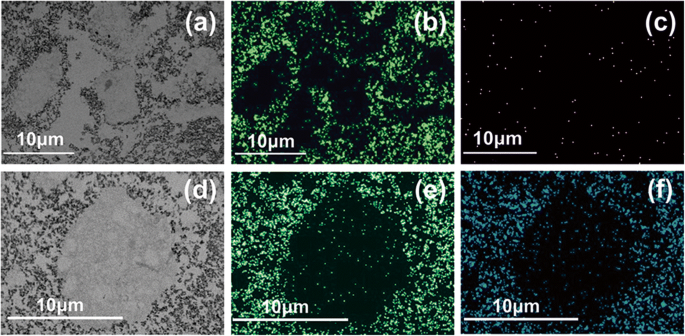
TEM images and elemental analysis of RE-NPs at the surface boundaries of A549 cells. un TEM image of small size LaF3 NPs surrounding the A549 cells. b Elemental analysis of F atoms in RE-NPs distributed around the cell. c Elemental analysis of La atoms. The low concentration of La atoms was associated with a rather small scattering efficiency of the X-rays. d - f The same as for (a - c ) for PrF3 RE-NPs
It was also evident that both RE-NPs were able to enhance AKT phosphorylation, especially in A549 cells (Fig. 9d), where the steady-state level of AKT pathway activity was higher for the SW837 cell line. The phosphorylation level for the MCF7 cell line was below the detection limit, in agreement with the relatively low levels of growth. High phosphorylation levels of ERK1/2 [36] and AKT were detected in A549 and SW837 cell lines. Cell growth was started once NPs with a proper size interact with the mechanosensors of the cells to provide the correct force for initiating cell growth [45, 46]. ERK and AKT pathways were frequently active in several cancer cell types via extracellular springing, as they were stimulated by the TSRs, upon a selective binding with various mitogenic ligands, or via the activation of the mechanosensory group. The interaction was responsible for a continuous intracellular stimulation that, according to the cell’s phenotype, driven the cancer cells to uncontrolled and endless growth. Viability tests were also run for 48 and 72 h, but the growth of all cell lines was saturated at 48 and 72 h after the initial moment of Cell plating.
Interaction of Cells with Ions
Likewise, as fluoride anions are the most reactive electronegative elements and, the mean radii extension of the unscreened 4f electronic configuration of La and Pr trivalent ions are relatively large, high electric surface charges could be developed via electric dipole interactions [47].
One crucial question stands whether a single ion binding on a specific site can activate tumour cell growth. Because the projected area of the 4f electronic configuration of a single RE ion is S 4f = 0.040 and 0.043 nm 2 (for an approximated spherical geometry of the 4f electronic configuration and a 4f mean orbital radii ~ r 4f =0.113 and 0.117 nm for Pr and La ions, respectively), a typical upper limit number of single RE ions, or other equivalent size ions, over the whole area of the cell membrane was ~ Sc / S 4f = N 4f ~7.9 × 10 9 RE ions; a number which is at least two orders of magnitude above the upper limit of the mean number of integrins on a tumour cell. As the relative overgrowth of cells was ascending with rising concentration (Fig. 9a), it is unlikely that tumour cell growth is triggered by a specific binding of single trivalent RE ions [48] on the ligand sites [49,50,51]. Indeed, the large number of RE ions should have saturated the cell’s growth and thus the viability of cells should have remain independent from the concentration of the RE ions.
Interaction of Integrins with RE-NPs
Within the requisite force range of few pN, and for efficient activation of integrins from NPs, the interaction between NPs and LABS should activate a large fraction of integrins of the cell for a long time. In the most extreme favoured case for cell growth, the number of NPs had to remain equal with the number of integrins on the cell’s surface, and the interactive force between LABS and NPs has to be attractive for obtaining a constant (long-term) action. A thin spherical shell of spherical NPs surrounding a tumour cell occupied a volume\( {V}_{sc}\approx 4\uppi {R}_c^2x \), where R c = 5 μm is the cell radius and x ≈ 20 nm is half the separating distance between adjacent integrin receptors and V sc ≈ 6.3 x 10 9 nm 3 . For justifying the requirement that each integrin receptor interacts only with one NP, a first estimation of the size of NPs to meet the above requirements for the whole set of integrins on a cell is obtained by dividing the volume of the spherical shell V sc with the number of integrins. A simple calculation for a cell radius 5 μm shows that the limits of radii of NPs activating the whole set of integrins within the spherical shell volume V sc ≈ 6.3 x 10 9 nm 3 covering the cell is obtained by divided the volume V sc with the number of integrins \( {\overline{N}}_{int}\approx 2\ \mathrm{x}\ {10}^5 \) and n int ≈ 1.6 x 10 7 . The volume of the spherical NPs stands for 3.15 × 10 4 and 3.93 × 10 2 nm 3 respectivamente. Therefore, the radii of the NPs interacting with an integrin lay between ~ 20 and 5 nm. Allowing for one order of magnitude variations in the number of integrins \( {\overline{N}}_{int} \), the radii of the NPs interacting with integrins is between ~ 27 and ~ 3 nm respectively.
By also applying similar simple calculations and within the experimental limits of concentration levels of RE-NPs (0.1–10 kg m −3 ), the maximum numbers of PrF3 with MHR 55–83 nm and LaF3 with MHR 296–100 nm NPs (Fig. 1g, h) covering the surface of a tumour cell V sc stood for 4.1 × 10 4 –2.1 × 10 4 and 17.1 × 10 2 –1.5 × 10 4 NPs. These values are placed well below the number of integrins on the cell surface. For rising concentrations of PrF3 and LaF3 from 0.1 and 10 kg m −3 , the number of PrF3 and LaF3 NPs in the suspensions must go up for either descending or ascending size of NPs. As viabilities of cancer cells are raised at higher concentration levels, it is unlikely that 55–296 nm sized RE-NPs are responsible for cancer cell mitosis under the current experimental configuration.
Also, from the DLS data, the size of both RE-NPs between 10 and 20 nm remained constant (10.6 nm) at different RE concentrations. The number of RE-NPs with this size covering the cell surface is between 3.7 × 10 5 and 1.5 × 10 6 . This number is comparable with the mean number of integrins \( {\overline{N}}_{int}\approx 2\ \mathrm{x}\ {10}^5 \) on a cell surface. Therefore, only small size RE-NPs have the potency to stimulate cancer cell growth by stimulating all the integrins on a cell surface, in agreement with the experimental observations (Figs. 1g, h and 9a).
The number of tiny sizes RE-NPs with MEAC diameter (TEM) from 2 to 10 and 10 to 15 nm on the cell surface (S c = 314 μm 2 ) stands for 1.3 × 10 4 and 1.8 × 10 4 RE-NPs, respectively. Those values stayed one order of magnitude below \( {\overline{N}}_{int}\approx 2\ \mathrm{x}\ {10}^5 \) and therefore tiny size RE-NPs had also the potency to justify the experimental results of rising viability values with concentration (Fig. 9a). Also, the rough surface of tumour cell (Fig. 9c) is able to form cavities, where small size RE-NPs are trapped, triggering thus cell’s mechanosensors. Most important, only tiny size RE-NPs have the potency to activate integrin receptors via electrical dipole interactions (vide infra).
Interaction of EGFR with RE-NPs
An upper limit of small size NPs capable of stimulating cell’s overgrowth via the EGFR was set previously to 14 nm [52], but a realistic size of NPs stimulating the EGFR should be < 5 nm [53] (Fig. 12). The area number density of EGFR on the surface of tumour cells stands for ~ 1.4 × 10 −4 nm −2 and the total number of EGFR on the surface S c of cells remains between ~ 4.2 x 10 4 and 10 5 [54,55,56]. RE-NPs with 5–10 nm size stayed for a number of 34 NPs (Fig. 3). Extrapolating this number to the surface of a cell S c , the total number of RE-NPs remained at ~ 10 4 NPs, a number which matches the number of EGFR receptors on a A549 cell. Therefore, the EGFR have the potency to be activated synergistically also by a number of tiny size RE-NPs.
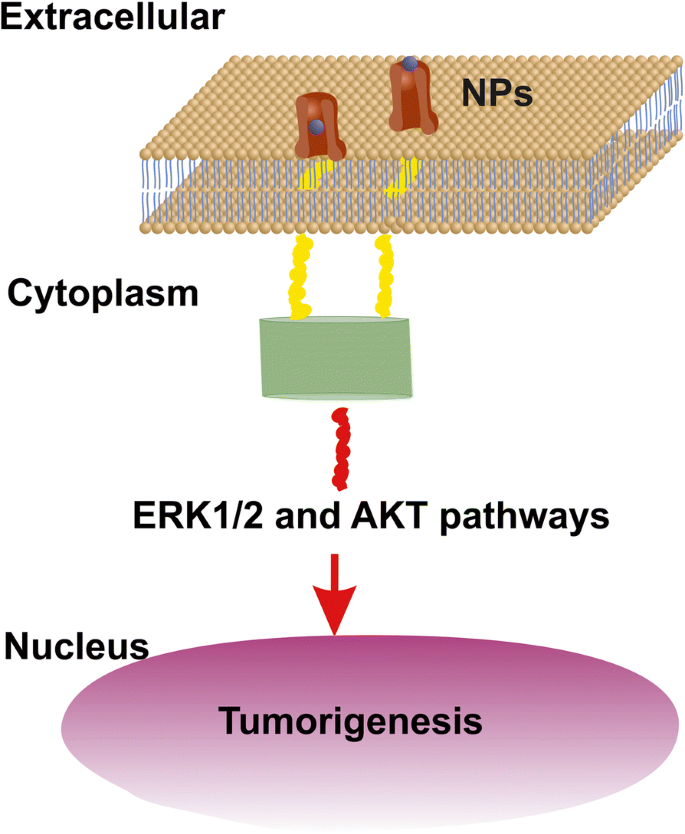
AKT and ERK1/2 signal transduction pathways activated by RE-NPs via EGFR stimulation. EGFR is activated only by tiny size ~ 5 nm NPs
Electric Dipole Interaction Between RE-NPs and LABS
The above experimental results are supported by the hypothesis of cancer cell growth from LABS stimulation by tiny size core-shell RE-NPs via electrical dipole interactions, Appendix.
Indeed, the mean electrical dipole force \( \left\langle {\overrightarrow{F}}_{V_2}\right\rangle \)acting on LABS from a core-shell RE-NP includes two terms (Fig. 13d and Appendix, Eq. A22). The first radial term is inversely proportional to the forth power of separating distance r 1 between the RE-NPs and LABS and is also proportional to the size of NP. The second polar term is inversely proportional to both the separating distance r 1 and the square power of the size of NP,
$$ \left\langle {\overrightarrow{F}}_{V_2}\right\rangle =-\frac{G_1{N}_2{N}_1\ d{e}^2}{4{\varepsilon}_0\ {r}_1\ }\theta \left(\ 3G\frac{b}{r_1^3}{\widehat{r}}_1+\frac{\theta }{2{b}^2}{\widehat{\theta}}_1\right)\kern0.75em (1) $$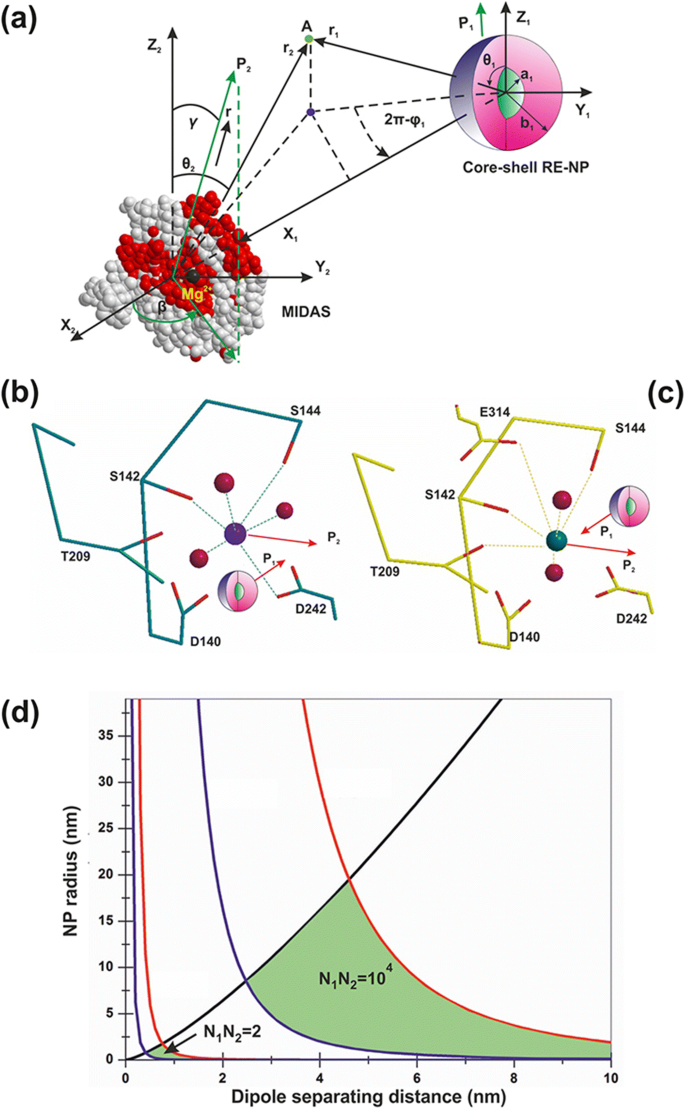
un Electrical dipole interaction between one core-shell RE-NP and one LABS. b , c RE core-shell NP near a MIDAS (b ) and ADMIDAS (c ) adhesion sites. d Locus area (green) of the size of RE-NPs and separating distance between a LABS and a core-shell RE-NP for two electrical charging states
En Eq. 1, G and G 1 are the geometrical factors of NPs, describing either core-shell or core spherical structures, Appendix, Eqs. A6 and A14; N 1 , N 2 are the numbers of surface electrons on the a RE-NPs and LABS surfaces; d and b are the effective characteristic spatial extension of atomic orbitals of LABS, ~ 0.1 nm, and the radius of RE-NP; e and ε 0 are the electron charge and the vacuum permittivity and \( \theta =\frac{d}{r_1}<0.01\ rad \). Because the core of the RE-NPs is a crystalline semiconductive material, an inherent large number of surface and volume defective sites were accountable for a high density of pseudo-electron energy levels that allowed the electrons to move freely within the core volume [46]. Consequently, a core-shell structure had the potency to be highly polarised. Therefore, LABS can be activated efficiently by core-shell RE-NPs via electrical dipole interactions at close separating distances. The high polarised efficiency of the core nucleus was confirmed experimentally via the selective orientation of NPs along two distinct directions (Fig. 2(a4–d4) and Fig. 3(a4, b4)).
The polar interaction force is also proportional to the geometrical factor G 1 , Appendix, Eq. A14. Typical values of dielectric constants of the culture media, shell configuration and RE core components stand for ε 1 = 78, ε 2 = 10 and ε 3 = 15. When the ratio of core-shell to core radii b/a sets within 1 and 50, the geometrical factors G , G 1 retain almost constant values (G = 0.2, G 1 = 0.01) and they are self-same for both a spherical core (b/a = 1) and a spherical core-shell. Any permanent or induced polarisation of an open or closed a-I-MIDAS domain forming the LABS domain has its origin on six coordinated water oxygen atomic orbitals with Mn 2+ or Mg 2+ ions, arranged in a spherical geometric configuration [7] (Fig. 12a–c).
As the electrical dipole force in Eq. 1 stands for the vector sum of a radial (first term) and a polar component (second term), the last term prevails over the first one provided that
$$ {r}_1>\sqrt[3]{6G}b\sim b\kern0.75em (2) $$In this case, a LABS is activated from the polar force component for all (b/a) ratios and, most important this term is inversely proportional to the second power of the size of NPs, in agreement with the experimental results that only tiny or small size LaF3 NPs activated cancer cell proliferation.
The prevailed polar force term for different r 1 and b values and for different Ν 1 , Ν 2 charging states activating the LABS/MIDAS stay within the limits [57,58,59,60].
$$ {10}^{-12}N<\frac{G_1{N}_2{N}_1\ d{e}^2}{8{\varepsilon}_0\ {r}_1{b}^2\ }{\theta}^2<{10}^{-9}N\kern1em (3) $$Inequality 3 relates the size b of the RE core-shell NPs, the separating distance r 1 and the number of the bound or free electrons Ν 2 , Ν 1 on the surface of the two dipoles. The locus of points (r 1 , b ) satisfying the inequality 3 for different surface charge states Ν 1 , Ν 2 is bounded by the black, red and blue lines (Fig. 13c). As there was no specific assumptions for the type of RE-NP, results can be equally applied for any type of polarised NPs.
When the algebraic product of the number of the surface electrons N 1 and N 2 (bound or free) on the LABS and the RE-NP, respectively, was N 1 N 2 = 2, the locus of RE-NPs size and separating distance for integrin activation was < 1 nm. At higher charging states, N 1 N 2 =10 4 , the locus area spans a wider RE-NPs size and separating distance area set of values, from 0.5 nm–19 nm to 2.5–15 nm, respectively.
From the above analysis, it is found that only tiny or small size NPs can activate LABS at a certain separating distance r 1 and the electrical dipole interaction strength decays inversely proportional to the second power of the size of NPs. From Fig. 13c and for a charging state with N 1 N 2 = 5 x 10 4 , the size of NPs capable to activate LABS is bounded by the limits
$$ 2.5\ \mathrm{nm}Conclusions
Cancer is a complex disease. Tumours are highly heterogeneous, and cell growth, among other factors, depends on dynamical interactions between cells and the continually changing extracellular matrix. Besides random genomic mutations, signal transductions in cells, activating cell growth can be triggered by mechanical, thermodynamic and electrical polar interactions between the microenvironment of the extracellular cell matrix and the membrane’s mechanosensors. Here, we demonstrated that tumour cell proliferation in three different human cancer cell lines (A549, SW837, MCF7) had the potency to be activated by a synchronised and synergetic activation of EGFR or via electrical dipole interactions between tiny size RE-NPs and the LABS of integrins on a cell.
Because the prerequisite force for integrin activation should stand between 10 −12 and 10 −9 N, the size of the active RE-NPs causing cell growth should be within certain limits. Cancer activation is specified by both the electrical surface charges on the LABS and the NPs and by their separating distance. This electric dipole activating force follows an inversely proportional square power law of the radius of NPs, evidencing that only tiny or small size RE-NPs have the potency to stimulate cancer cell growth via electrical dipole interactions, in agreement with the experimental results.
Methods
Synthesis of RE-NPs
PrF3 NPs were synthesised via co-precipitation. Briefly, 4 g of Pr2 O 3 were added to 110 mL of 10% nitric acid in a polypropylene glass beaker together with 3 g of NaF under stirring. The mixture was heated to 50 °С and stirred for 45 min until a clear light-green solution appeared. Then it was filtered. The pH of the mixture adjusted to 4 by adding 25% of ammonium hydrate. Next, the mixture was stirred again for 20 min. Finally, the precipitated NPs washed with distilled water by centrifugation.
LaF3 NPs were also synthesised by applying the same protocol in a mixture of La2 O 3 (4 g) and NaF (3 g). From both preparations, an aliquot of the suspensions containing NPs was air-dried for structural analysis and the remaining part kept as water suspension for the biological studies.
The suspensions of NPs were prepared in complete DMEM+FBS cell culture medium by adding water suspended NPs directly to the medium to a final concentration of 5 mM. Then, starting from the 5 mM stock solution, some subsequent dilutions using DMEM as a solvent were prepared to a final NPs concentration of 1 mM and 0.5 mM, respectively.
Size Distribution of RE-NPs
XRD
The crystal structure and the size of PrF3 and LaF3 NPs were characterised by XRD spectroscopy, with an X-ray diffractometer (Shimadzu XRD-7000S) in the 2θ range from 10° to 80° using the graphite monochromatised Cu-Ka radiation (1.5406 Å). The weighted average of τ for all peaks was used in the statistics. Weighting, besides β, took into account the relative intensity of every peak of the XRD spectra. The corresponding errors incorporate the reading error (0.3 mrad) and the standard error of the mean (se = σ / √ Ν ).
DLS
The size distribution and the MHR of RE-NPs in water and DMEM+FBS suspension were determined for comparison by DLS at 632.8 nm and right angles at 37 °C with a multi-angle dynamic and static light scattering instrument (PHOTOCOR-FC). The values of the MHR (Stokes radius) and the size distribution of NPs were calculated from the autocorrelation spectra and the Stokes-Einstein relation with the DynaLS software. Because the intensity of scattered light in pure DMEM+FBS was 20 times lower than with RE-NPs additives, the level of aggregating proteins in pure DMEM+FBS was negligible compared with mixed suspensions of RE-NPs in DMEM+FBS medium. MHR and RE-NPs size distribution and size errors were obtained by fitting and processing the data from the DLS instrument with the DynaLS software that allows the MHR to be calculated in different spectral domains of the main size distributions, from 10–10 2 to 10 2 –10 3 nm, Additional file 2.
AFM
Because size distribution below 15 nm was close to the low limit range of DLS, AFM was also applied to evaluate small size distribution. At low concentration of RE-NPs in liquid suspensions and slow drying rates of droplets on glass substrates, the deposits reflected the size distribution in the liquid suspensions [37]. Following the dispersion of RE-NPs in ethanol or DMEM+FBS, a drop of suspension was placed on a clean glass substrate using a micropipette, and then it was dried in air at room temperature for AFM imaging and analysis (diInnova, Bruker). AFM was performed in the tapping mode, in ambient conditions with a phosphorus-(n)-doped silicon cantilever (Bruker, RTESPA-CP), having a nominal spring constant of 40 nN/nm and operating at a resonance frequency of 300 kHz. Surface areas of various sizes (0.5 × 0.5–50 × 50 μm 2 ) were imaged with high spatial resolution (512 px × 512 px) at a scanning rate of 0.2 Hz to identify domains with different size distributions via “scan area filtering” [37]. From the morphological analysis by the SPM LabAnalysis V7 software, the particle’s size distribution, shape and aggregation stage were determined.
The size of NPs for different scanning areas was also noticeable by the particle analysis chromatic bar (Fiji integrated ROI colour coder based on MEAC diameter) (Fig. 2(a1–d1)). The AFM image was transformed into a binary image using an appropriate z -height threshold. Every pixel of the processed image contained information not only for the z -height in the pixel area but also for the presence of particles in the pixel area. The x -histograms of MEAC and Ferret diameter (Fig. 2(a2–d2, a3–d3)) were extracted by using the “Image J 1.51n Fiji distribution software”, with the correct z -height threshold values. The size resolution per pixel was 3.9 and 1.9 nm for PrF3 and LaF3 respectivamente.
The particle identification, the noise extraction and the particle area data were processed by the “Particle Analyser function” of Fiji software (Fig. 2(a1–d1)). The particle diameter histograms were also analysed. Both the equal area circle diameter (Fig. 2(a2–d2)) and Feret diameter or “calliper diameter” (maximum diameter of a particle among all directions) (Fig. 2(a3–d3)), whose direction was the Feret angle (Fig. 2(a4–d4)), were analysed. The mean equal area circle diameter and the mean Feret diameter were calculated taking into account all particles identified. The associated errors incorporated the actual pixel size in every AFM image and the standard error of the mean (se = σ / √ Ν ).
A t test was performed for every set of AFM images based in the “null hypothesis” that the mean particle diameter was the same for all the AFM images between randomly selected figures (Fig. 2(a1–b1, c1, d1)). The p value (probability that the null hypothesis based on t distribution is not valid) is shown in Additional file 2.
TEM
The same technique was followed for calculating the above parameters in TEM imaging (Fig. 3(a1–b4)). Atomic resolution TEM (Hitachi HT7700 Exalens) imaged either extracellular or intracellular RE-NPs attachment on the A549 cells fixed in glutaraldehyde. Elemental analysis of F, La and Pr were also carried out (Oxford Instruments X-Max 80T).
2D-FFT
Additional information on the NPs size distribution in the (x , y ) plane was also extracted from the 2-D Fourier transform of AFM images of NPs using the relation
$$ I\left({k}_x,{k}_y\ \right)=\iint f\left(x,y\right)\exp \left(i{k}_xx\right)\exp \left(i{k}_yy\right) dxdy $$where f ( x , y ) is a size function at a point (x, y ), k x , k y are the associated wavevectors in the inverse Eukledian space at the same point and I (k x , k y ) is the “spectral density” of the function f ( x , y ) at the point k x , k y . For most applications, f ( x , y ) is the z -height of the NPs at the point (x, y ) and z = f ( x , y ).
For a set of discrete data, such as the digitised AFM images, the 2D-FFT was used instead of 2D Fourier transform in the continuous space. For a m × n X-matrix (pixels of an AFM image), the 2D-FFT transform takes the form
$$ \kern1em {Y}_{p+1,q+1}=\sum \limits_{j=0}^{m-1}\sum \limits_{k=0}^{n-1}{\omega}_m^{jp}{\omega}_n^{kq}{X}_{j+1,k+1\kern1.25em } $$where \( {\omega}_m^{jp}={e}^{2 pi/m},{\omega}_n^{kq}={e}^{2 pi/n} \) are the associated frequencies. Then, an appropriate shift along the y -axis was performed and the integers m, n, p, q, k were translated into lengths and inverse lengths respectively by a multiplication with the pixel’s size of the image.
Water Trapping in RE-NPs
VUV Spectroscopy
To appraise the state of water in RE-NP’s complexes during the initial stage of suspension preparation, the adsorption of water molecules on the surface of the hygroscopic PrF3 NPs was identified with a laboratory-made VUV (110–180 nm) absorption spectrometer. It consists of a hydrogen lamp operating in a longitudinal stabilised discharge mode at 10 kV, a stainless steel vacuum chamber and a VUV monochromator (Acton VM502), equipped with a solar blind photomultiplier (Thorn EMI 9412 CsTe) and a laboratory-made data collection system. Thin layers of PrF3 NPs suspensions in water were prepared and dried on 1-mm-thick VUV-grade CaF2 substrates by applying the “drop-casting method”. Then, the CaF2 substrates were placed in the optical path between the hydrogen lamp and the VUV monochromator in a vacuum. The stainless steel 316 vacuum chamber was evacuated initially to 10 − 7 mbar using two turbomolecular pumps at a differential pumping configuration (Edwards EXT 100/200, pumping speed 150 ls −1 ). However, a high outgassing rate of PrF3 sets an upper limit to the background pressure in the vacuum chamber ~ 8.5 × 10 −5 mbar. The relatively low background pressure of both compounds irreversibly damages the VUV optics and the turbomolecular pump after few hours of operation and therefore it sets certain experimental constraints, preventing an equivalent registration of LaF3 spectrum because of high outgassing rates and a low background operating pressure (< 10 −4 mbar). The experimental data (light transmitted through the sample film on CaF2 window) were fitted to a logarithmic response for calculating the transmittance.
Cell Culture and Growth Assay
Cell Growth
The A549 and SW837 cell lines were maintained in DMEM+FBS, whereas the MCF7 lines were in RPMI+FBS. Both media supplemented with 10% fetal bovine serum (FBS), 1 × penicillin, 1 × streptomycin and 2 mM l-glutamine. Cells were incubated at 37 °C, 5% CO2 in a humidified atmosphere.
The WST viability test was used to monitor the intrinsic toxicity of PrF3 and LaF3 NPs for three human cancer cell lines, A549, SW837 and MCF7. For the viability assay, three different concentrations of RE solubles (0.5, 1 and 5 mM) in DMEM+FBS (A549, SW837) and RPMI+FBS (MCF7) were used. The initial number of cells seeded in the 96-well plates was ~ 5 × 10 4 cells/well. This amount of cells was plated 24 h prior to the RE-NPs treatment of cells in order to allow enough time for the cells to attach properly to the plate (wells) and to attain the optimum growing conditions. Subsequently, the viability test was performed 24 h after RE-NPs addition, or 48 h after the initial cell cultures were placed in the wells. As we did not observe any cell reduction, but on the contrary cell-overgrowth, especially with the SW620 cell line at 5 mM, the cell confluence quickly reached 80–90% of its initial value after 24 h of the addition of RE-NPs or 48 h from the initial plating.
Five microliters of WST solution was added to each well and the plate was incubated for 1 h during the growth state. The absorbance at 450 nm of each well was measured using a microplate reader (Biorad, x Mark). Each experimental point for each cell line and each RE suspension was extracted from two samples and triplicated every 2 days (total of 108 samples).
F test was used for every set of cell viability measurements. Here, the “null hypothesis” was that the relative to the CTRL “mean viability value was the same at different concentrations within the same cell line”. With this null hypothesis, an unknown law connecting tumour cell viability and RE-NPs concentration was identified. The p value (probability the null hypothesis to be rejected) was also tested from the F distribution Additional file 1.
Western Blotting and Antibodies
Total proteins were extracted with 60 μL of radioimmunoprecipitation assay (RIPA) lysis buffer (20 mM Tris-HCl (pH 7.5); 150 mM NaCl, 1 mM Na2 EDTA; 1 mM EGTA; 1% NP-40; 1% sodium deoxycholate; 2.5 mM sodium pyrophosphate; supplemented with proteases inhibitors 1 mM β-glycerophosphate; 1 mM Na3 VO4 1 μg/ml; leupeptin) and the Wb assay was performed according to standard protocols (Fig. 9b). Briefly, total proteins (50 μg) were separated by SDS-polyacrylamide gel electrophoresis (SDS-PAGE) and transferred to nitrocellulose membrane. Blots were incubated overnight at 4 °C with appropriate primary antibodies. The antibodies used were tubulin code sc-8035, from Santa Cruz (final concentration 1:1000 in blocking buffer); p-ERK (E-4) code sc-7383, from Santa Cruz (final concentration 1:500 in blocking buffer); and p-AKT (Thr308) code 9275S, from Cell Signaling (final concentration 1:1000 in blocking buffer).
Wb bands are collected from different blots showing quality control of antibodies specificity. Numbers at the top of the phosphorylation images show grey scale levels from 0 (black) to 168 (grey) (maximum value ), indicating activation at a non-saturated mode.
Abreviaturas
- 2D-FFT:
-
Two-dimensional fast Fourier transform
- ADMIDAS:
-
Adjacent MIDAS
- AFM:
-
Microscopía de fuerza atómica
- AKT:
-
Protein kinase B
- CTRL:
-
Control cells
- DLS:
-
Dispersión de luz dinámica
- DMEM:
-
Dulbecco’s modified Eagle’s medium
- ECM:
-
Cell-extracellular matrix
- EGFR:
-
Epidermal growth factor receptors
- ERK:
-
Extracellular signal-regulated kinase
- F.A.:
-
Feret angle
- F.D.:
-
Feret area diameters
- FBS:
-
Fetal bovine serum
- LABS:
-
Ligand adhesion binding site
- MEAC:
-
Mean equal area circle
- MHR:
-
Mean hydrodynamic radius
- MIDAS:
-
Metal ion-dependent adhesion sites
- NGFR:
-
Nerve growth factor receptor
- NP:
-
Nanopartícula
- RE-NPs:
-
Rare-earth nanoparticles
- RIPA:
-
Radioimmunoprecipitation assay
- RMS:
-
Root mean square
- RPMI:
-
Roswell Park Memorial Institute medium
- SDS-PAGE:
-
Sodium dodecyl sulfate-polyacrylamide gel electrophoresis
- SyMBS:
-
Synergistic metal ion binding sites
- TEM:
-
Microscopía electrónica de transmisión
- TSR:
-
Transmembrane signal receptors
- VEGFR:
-
Vascular endothelial growth factor
- VUV:
-
Vacuum ultraviolet
- Wb:
-
Western blot assays
- WST:
-
Water-soluble tetrazolium salts
- XRD:
-
Difracción de rayos X
Nanomateriales
- Acerca de las nanopartículas semiconductoras
- Nanopartículas de FePO4 biocompatibles:administración de fármacos, estabilización de ARN y actividad funcional
- Estudio in vitro de la influencia de nanopartículas de Au en las líneas celulares HT29 y SPEV
- Poliglicerol hiperramificado modificado como dispersante para el control del tamaño y la estabilización de nanopartículas de oro en hidrocarburos
- Promoción del crecimiento celular SH-SY5Y mediante nanopartículas de oro modificadas con 6-mercaptopurina y un péptido penetrante de neuronas
- Las nanopartículas de maghemita actúan como nanozimas, mejorando el crecimiento y la tolerancia al estrés abiótico en Brassica napus
- Nanopartículas luminiscentes de persistencia Gallogermanate de zinc codopado de Cr3 + / Eu3 + de emisión de infrarrojo cercano para la obtención de imágenes celulares
- Nanocomposites a base de óxido de grafeno decorados con nanopartículas de plata como agente antibacteriano
- Nanopartículas de oro de forma redonda:efecto del tamaño de partícula y la concentración sobre el crecimiento de la raíz de Arabidopsis thaliana
- Síntesis in situ de nanopartículas bimetálicas de tungsteno-cobre mediante plasma térmico de radiofrecuencia (RF) reactiva
- El poli (ácido γ-glutámico) promueve la decloración mejorada de p-clorofenol mediante nanopartículas de Fe-Pd



